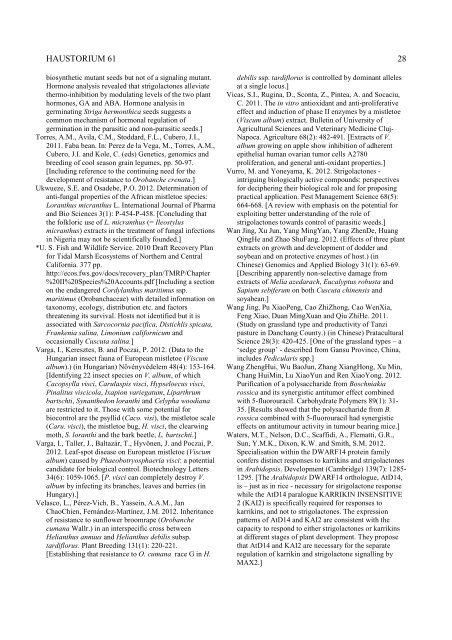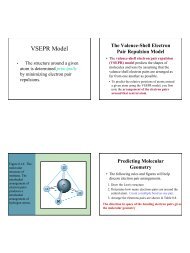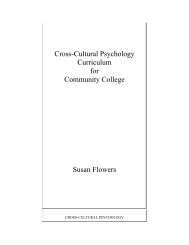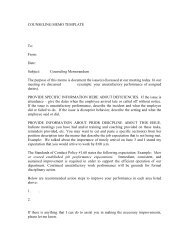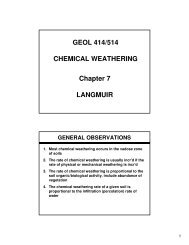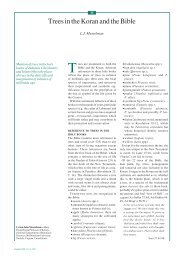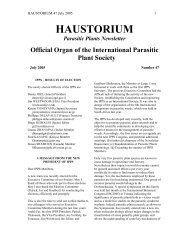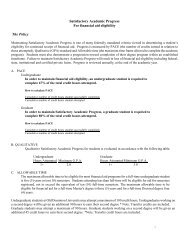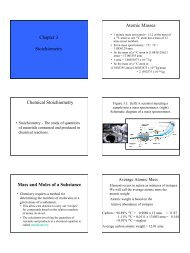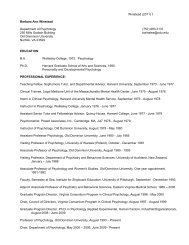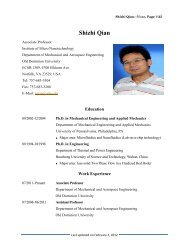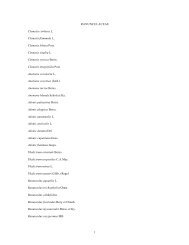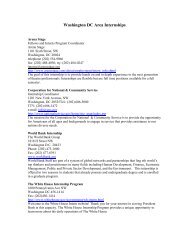HAUSTORIUM
HAUSTORIUM
HAUSTORIUM
Create successful ePaper yourself
Turn your PDF publications into a flip-book with our unique Google optimized e-Paper software.
<strong>HAUSTORIUM</strong> 61 28<br />
biosynthetic mutant seeds but not of a signaling mutant.<br />
Hormone analysis revealed that strigolactones alleviate<br />
thermo-inhibition by modulating levels of the two plant<br />
hormones, GA and ABA. Hormone analysis in<br />
germinating Striga hermonthica seeds suggests a<br />
common mechanism of hormonal regulation of<br />
germination in the parasitic and non-parasitic seeds.]<br />
Torres, A.M., Avila, C.M., Stoddard, F.L., Cubero, J.I.,<br />
2011. Faba bean. In: Perez de la Vega, M., Torres, A.M.,<br />
Cubero, J.I. and Kole, C. (eds) Genetics, genomics and<br />
breeding of cool season grain legumes, pp. 50-97.<br />
[Including reference to the continuing need for the<br />
development of resistance to Orobanche crenata.]<br />
Ukwueze, S.E. and Osadebe, P.O. 2012. Determination of<br />
anti-fungal properties of the African mistletoe species:<br />
Loranthus micranthus L. International Journal of Pharma<br />
and Bio Sciences 3(1): P-454-P-458. [Concluding that<br />
the folkloric use of L. micranthus (= Ileostylus<br />
micranthus) extracts in the treatment of fungal infections<br />
in Nigeria may not be scientifically founded.]<br />
*U. S. Fish and Wildlife Service. 2010 Draft Recovery Plan<br />
for Tidal Marsh Ecosystems of Northern and Central<br />
California. 377 pp.<br />
http://ecos.fws.gov/docs/recovery_plan/TMRP/Chapter<br />
%20II%20Species%20Accounts.pdf [Including a section<br />
on the endangered Cordylanthus maritimus ssp.<br />
maritimus (Orobanchaceae) with detailed information on<br />
taxonomy, ecology, distribution etc. and factors<br />
threatening its survival. Hosts not identified but it is<br />
associated with Sarcocornia pacifica, Distichlis spicata,<br />
Frankenia salina, Limonium californicum and<br />
occasionally Cuscuta salina.]<br />
Varga, I., Keresztes, B. and Poczai, P. 2012. (Data to the<br />
Hungarian insect fauna of European mistletoe (Viscum<br />
album).) (in Hungarian) Növényvédelem 48(4): 153-164.<br />
[Identifying 22 insect species on V. album, of which<br />
Cacopsylla visci, Carulaspis visci, Hypseloecus visci,<br />
Pinalitus viscicola, Ixapion variegatum, Liparthrum<br />
bartschti, Synanthedon loranthi and Celypha woodiana<br />
are restricted to it. Those with some potential for<br />
biocontrol are the psyllid (Caco. visi), the mistletoe scale<br />
(Caru. visci), the mistletoe bug, H. visci, the clearwing<br />
moth, S. loranthi and the bark beetle, L. bartschti.]<br />
Varga, I., Taller, J., Baltazár, T., Hyvönen, J. and Poczai, P.<br />
2012. Leaf-spot disease on European mistletoe (Viscum<br />
album) caused by Phaeobotryosphaeria visci: a potential<br />
candidate for biological control. Biotechnology Letters<br />
34(6): 1059-1065. [P. visci can completely destroy V.<br />
album by infecting its branches, leaves and berries (in<br />
Hungary).]<br />
Velasco, L., Pérez-Vich, B., Yassein, A.A.M., Jan<br />
ChaoChien, Fernández-Martínez, J.M. 2012. Inheritance<br />
of resistance to sunflower broomrape (Orobanche<br />
cumana Wallr.) in an interspecific cross between<br />
Helianthus annuus and Helianthus debilis subsp.<br />
tardiflorus. Plant Breeding 131(1): 220-221.<br />
[Establishing that resistance to O. cumana race G in H.<br />
debilis ssp. tardiflorus is controlled by dominant alleles<br />
at a single locus.]<br />
Vicas, S.I., Rugina, D., Sconta, Z., Pintea, A. and Socaciu,<br />
C. 2011. The in vitro antioxidant and anti-proliferative<br />
effect and induction of phase II enzymes by a mistletoe<br />
(Viscum album) extract. Bulletin of University of<br />
Agricultural Sciences and Veterinary Medicine Cluj-<br />
Napoca. Agriculture 68(2): 482-491. [Extracts of V.<br />
album growing on apple show inhibition of adherent<br />
epithelial human ovarian tumor cells A2780<br />
proliferation, and general anti-oxidant properties.]<br />
Vurro, M. and Yoneyama, K. 2012. Strigolactones -<br />
intriguing biologically active compounds: perspectives<br />
for deciphering their biological role and for proposing<br />
practical application. Pest Management Science 68(5):<br />
664-668. [A review with emphasis on the potential for<br />
exploiting better understanding of the role of<br />
strigolactones towards control of parasitic weeds.]<br />
Wan Jing, Xu Jun, Yang MingYan, Yang ZhenDe, Huang<br />
QingHe and Zhao ShuFang. 2012. (Effects of three plant<br />
extracts on growth and development of dodder and<br />
soybean and on protective enzymes of host.) (in<br />
Chinese) Genomics and Applied Biology 31(1): 63-69.<br />
[Describing apparently non-selective damage from<br />
extracts of Melia azedarach, Eucalyptus robusta and<br />
Sapium sebiferum on both Cuscuta chinensis and<br />
soyabean.]<br />
Wang Jing, Pu XiaoPeng, Cao ZhiZhong, Cao WenXia,<br />
Feng Xiao, Duan MingXuan and Qiu ZhiHe. 2011.<br />
(Study on grassland type and productivity of Tanzi<br />
pasture in Danchang County.) (in Chinese) Pratacultural<br />
Science 28(3): 420-425. [One of the grassland types – a<br />
‘sedge group’ - described from Gansu Province, China,<br />
includes Pedicularis spp.]<br />
Wang ZhengHui, Wu BaoJun, Zhang XiangHong, Xu Min,<br />
Chang HuiMin, Lu XiaoYun and Ren XiaoYong. 2012.<br />
Purification of a polysaccharide from Boschniakia<br />
rossica and its synergistic antitumor effect combined<br />
with 5-fluorouracil. Carbohydrate Polymers 89(1): 31-<br />
35. [Results showed that the polysaccharide from B.<br />
rossica combined with 5-fluorouracil had synergistic<br />
effects on antitumour activity in tumour bearing mice.]<br />
Waters, M.T., Nelson, D.C., Scaffidi, A., Flematti, G.R.,<br />
Sun, Y.M.K., Dixon, K.W. and Smith, S.M. 2012.<br />
Specialisation within the DWARF14 protein family<br />
confers distinct responses to karrikins and strigolactones<br />
in Arabidopsis. Development (Cambridge) 139(7): 1285-<br />
1295. [The Arabidopsis DWARF14 orthologue, AtD14,<br />
is – just as in rice - necessary for strigolactone response<br />
while the AtD14 paralogue KARRIKIN INSENSITIVE<br />
2 (KAI2) is specifically required for responses to<br />
karrikins, and not to strigolactones. The expression<br />
patterns of AtD14 and KAI2 are consistent with the<br />
capacity to respond to either strigolactones or karrikins<br />
at different stages of plant development. They propose<br />
that AtD14 and KAI2 are necessary for the separate<br />
regulation of karrikin and strigolactone signalling by<br />
MAX2.]


